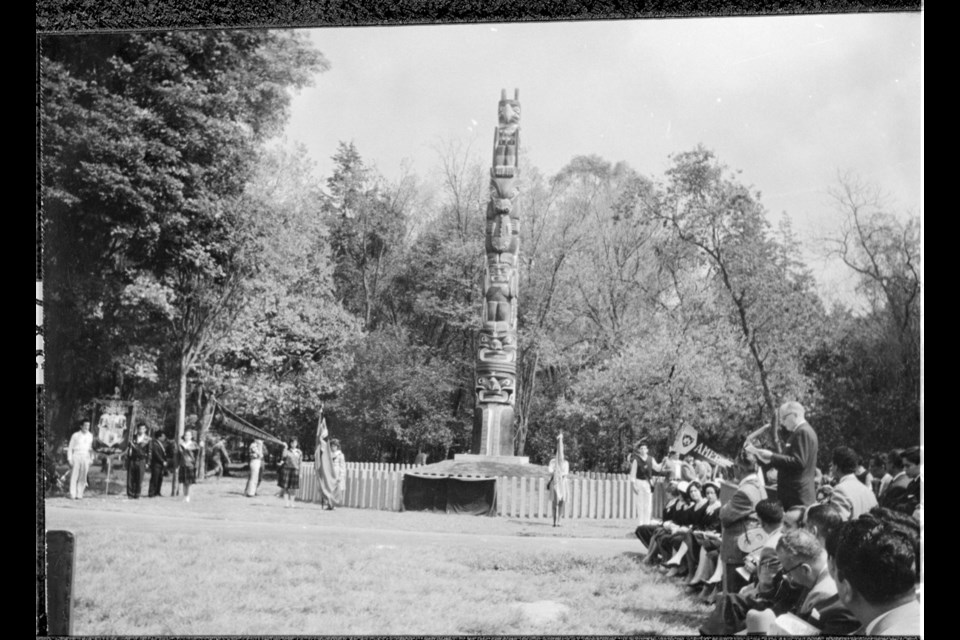A goodwill project to restore an aging Vancouver Island totem pole in Mexico City isn’t the first to rub artist Tony Hunt Sr. the wrong way.
Hunt said he carved the totem pole under the direction of his grandfather, acclaimed artist Mungo Martin, at Victoria’s Thunderbird Park in the 1961. But instead of being asked to restore the totem pole himself, he said, he was invited to act as a consultant for restoration experts.
“It’s total disrespect. Not just to me, but to my grandfather, who was one of the greatest artists of his time,” he said. “It’s like sending a carpenter to repaint the Mona Lisa.”
The 37-foot pole was commissioned by the federal government as a gift to Mexico on the 150th anniversary of its independence, according to the Royal B.C. Museum.
It was the first totem pole Hunt worked on with his grandfather and one of Martin’s last major projects. Hunt said Martin designed the pole, while Hunt carved it. (Royal B.C. Museum records show that Tony’s father, Henry Hunt, also participated in the project, but Tony said he did it alone with his grandfather. He is the only surviving artist among the three.)
“I followed [Martin’s] design using the tools that I’ve now inherited,” he said.
A proper restoration couldn’t occur without those handcrafted tools, Hunt said.
Hunt has carved about 100 totem poles worldwide, many of which have been repaired without his input, he said. In some cases, fir or spruce was used in place of traditional red cedar, he said; in others, basic chisels were used instead of the original tools.
“This has happened lots of times with projects that I did 40, 50 years ago,” he said. “Nobody has ever done a proper repair job on anything I’ve made.”
The initiative to restore the pole came from another Victoria resident. Clayton Restall, whose wife is Mexican, said he noticed a Canadian totem pole in Chapultepec Park needed some care.
When he looked into its history, he realized that he had likely watched the pole being carved when he was 13.
“I used to ride my bicycle across the city to the breakwater to go fishing. On the way, I’d stop by Thunderbird Park,” Restall said.
Restall contacted the Canadian Embassy in Mexico City about the condition of the pole. The embassy is now co-ordinating the project, he said, while the Canadian Chamber of Commerce in Mexico is financing it.
The restoration celebrates 70 years of diplomatic relations between Canada and Mexico, embassy communications officer Gloria Antonetti said in an email.
She described Chapultepec Park as the Mexican equivalent to Central Park in New York City, where tens of millions of Mexicans gather throughout the year.
Martin’s work is one of three Canadian totem poles in Mexico, she said.
Bowen Island-based conservator Andrew Todd, whom Restall called an “internationally recognized restoration expert,” will work with Mexican restorer Patricia Mendez. Two Kwakwaka’wakw carvers will assist them.
An expert familiar with totem pole restorations said hiring a conservator for such a project is routine.
Todd said several artists have hired him directly to restore their work, including Haida artist Robert Davidson. He has also repaired totem poles at the Alaska State Museum, the Vancouver International Airport, as well as Martin’s totem pole at Windsor Great Park in England.
Todd said he came to totem pole restoration through his training in wood preservation technology.
He assessed the pole in February. He said exposure to the elements is weathering the pole’s exterior. The design is becoming less clear and there are “loose and broken” pieces of wood. He also has concerns about the bottom of the pole, which was grounded in a concrete base.
But he said the integrity of the pole as a whole is still strong.
The restoration process takes 10 steps, he said, including cleaning the surface, applying a preservation product to deter insects and moss, and recarving new wood to match the original.
He said he would not refer to himself as the go-to guy for totem poles.
“The ‘guys’ are really the artists. I’m just the conservator who does the brake jobs and the oil changes to try to keep the artwork looking as great as it is,” Todd said.
He said it’s been an honour to work on Martin’s poles and said he was sorry to hear about Hunt’s objection.
“[Martin] is one of the greatest of all time. He was really instrumental in maintaining the art form through a really difficult period historically,” Todd said, referring to the potlatch ban.
“He somehow managed to keep working and convincing people at the museum in Victoria that the work he was doing was important. They saw that,” Todd said.
He called it rewarding to have responsibility for preserving important First Nations art.
Todd said objections about conservators from artists are not unheard of, but rare.
Antonetti said Todd was selected for his experience restoring totem poles of similar age and exposure for the Canadian government.
“The embassy has great appreciation for Mr. Hunt’s work and we are considering possibilities for future collaboration,” she said.



